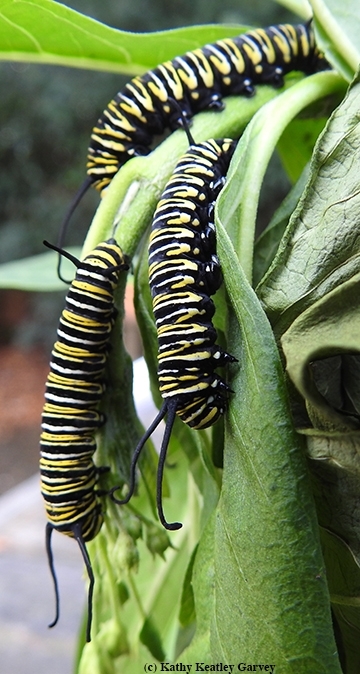
Greg Kareofelas, a Bohart Museum of Entomology associate with expertise on local butterflies, will be at the Bohart Museum's open house on Sunday, March 19 from 1 to 4 p.m. to meet informally with visitors, talk about butterflies and answer their questions.
The open house, themed "Eggs to Wings: Backyard Butterfly Gardening," takes place in Room 1124 of the Academic Surge Building on Crocker Lane, UC Davis campus. It is free and open to the public. No reservations are required.
“I've always had an interest in butterflies since I was a little kid,” said Kareofleas, a Davis resident who has studied butterflies “seriously” since the late 1970s. "Back then, there was no Internet and books on butterflies in California were minimal and it seemed that most of the books published were on East Coast butterflies or butterflies out of our region. It was the late 1970s, after all, and we couldn't just go on the Internet for butterfly identification.”
It was then that Kareofelas met butterfly guru Arthur Shapiro, UC Davis distinguished professor of evolution and ecology. Shapiro, involved in butterfly research for more than four decades, now posts his work on his website.) Shapiro authored Field Guide to Butterflies of the San Francisco Bay and Sacramento Valley Regions (University of California Press, 2007).
Kareofelas, a naturalist and avid photographer, now spends much of his time researching and photographing butterflies, as well as dragonflies and other insects, and speaking to nature-oriented organizations. He is also a regular at the Bohart Museum open houses where he enthusiastically talks about insects he's encountered.
UC Davis offers great resources, Kareofelas says. “For instance, you can get an insect identified at the Bohart Museum, and a plant identified at the Herbarium. And then there are the great resources like the Sacramento Native Plant Society, the UC Davis Botanical Society and the UC Davis Arboretum and Public Garden."
Kareofelas is pleased to see the growing interest in butterflies and their larval host plants (where butterflies lay their eggs). “All you need is a yard to attract them,” he said. “Plant the larval host plants. Plant nectar plants, such as the butterfly bush, for the adults."
Want monarchs living in our backyard? “Plant milkweed, their larval host plant," Karofelas says.
Kareofelas mentioned a few host plants that will draw specific species:
- Plant pipevine, aka Dutchmen's pipe, for the Pipevine Swallowtails
- Plant passionflower vine for the Gulf Fritillaries
- Plant fennel for the Anise Swallowtails
- Plant baby tears (in the nettle family) for Red Admirals
- Plant snagdragons for Buckeyes
- Plant Rose of Sharon for the Gray Hairstreaks
- Plant mallow for the Checkered Skippers
Kareofelas has reared all the common species, as well some of the rare ones, including the California dogface butterfly, the state insect. With permission, he collected eggs from the rarely seen California dogface butterfly at its most populous breeding site, on Placer Land and Trust acreage near Auburn. The butterfly (Zerene eurydice) lays its eggs on false indigo (Amorpha californica).
Kareofelas, who serves as a guide several times a year for tours hosted by Placer Land and Trust, said that one result of rearing the California dogface butterfly is the publication of the 35-page children's book, "The Story of the Dogface Butterfly," written by Bohart associate Fran Keller (now an assistant professor at Folsom Lake College) with illustrations by then UC Davis student Laine Bauer, and photos by Kareofelas and Keller.
The book, available in the Bohart Museum's gift shop, tells the untold story of the California dogface butterfly, and how schoolchildren became involved in convincing the State Legislature to select the colorful butterfly as the state insect. (See Bug Squad.)
The Bohart Museum's open house on Sunday will showcase butterflies in the area. A family craft activity will be making "wiggling caterpillars," with straw and paper, said Tabatha Yang, education and outreach coordinator for the Bohart.
Directed by Lynn Kimsey, professor of entomology at UC Davis, the Bohart Museum is a world-renowned insect museum that houses a global collection of nearly eight million specimens. It also maintains a live “petting zoo,” featuring walking sticks, Madagascar hissing cockroaches and tarantulas. A gift shop, open year around, offers T-shirts, sweatshirts, books, jewelry, posters, insect-collecting equipment and insect-themed candy.
The Bohart Museum's regular hours are from 9 a.m. to noon and 1 to 5 p.m. Mondays through Thursdays. The museum is closed to the public on Fridays, Saturdays and Sundays and on major holidays. Admission is free. Special open houses take place throughout the academic year. The one on March 19 is the second to the last of the 2016-2017 academic year. The last one is Saturday, April 22, the campuswide UC Davis Picnic Day.
More information on the Bohart Museum is available by contacting (530) 752-0493 or bmuseum@ucdavis.edu. The website is http://bohart.ucdavis.edu/
Attached Images:
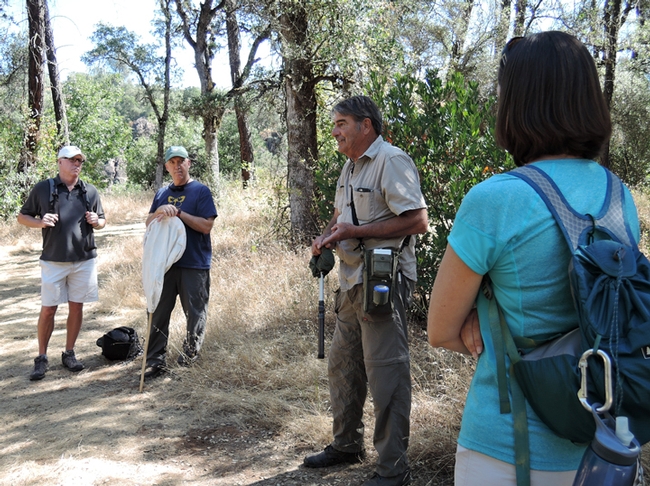
Bohart Museum associate Greg Kareofelas talks to butterfly enthusiasts on a Placer Land and Trust tour looking for the California dogface butterfly, the state insect. (Photo by Kathy Keatley Garvey)
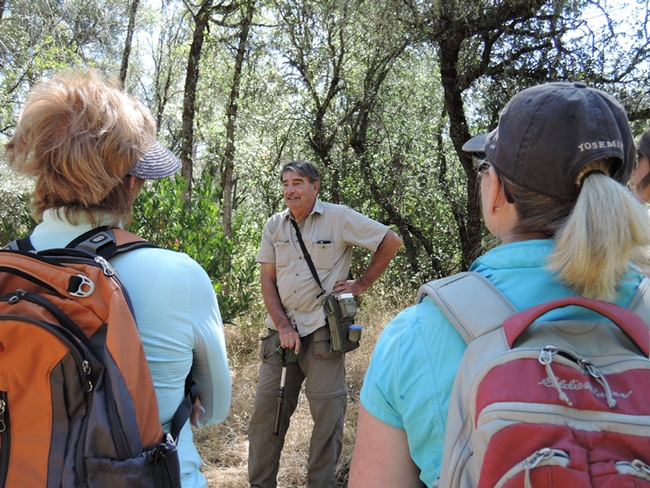
Framed by hikers, Greg Kareofelas tells the history of the California dogface butterfly, the state insect. This photo was taken on Placer Land and Trust acreage near Auburn. (Photo by Kathy Keatley Garvey)
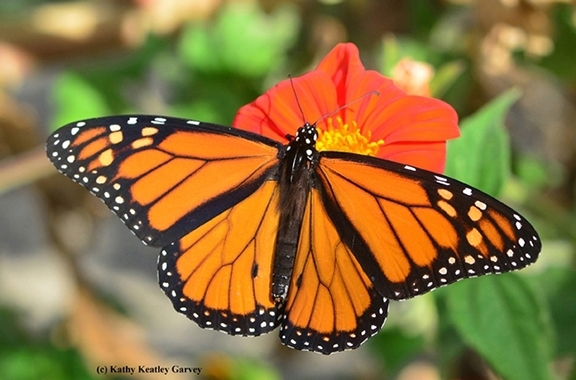
Want to attract monarchs? Plant their larval host plant, milkweeds. Nectar plants? They like Mexican sunflower (Tithonia) and the butterfly bush (Buddleja davidii), among others. This photo shows a monarch on Tithonia. (Photo by Kathy Keatley Garvey)
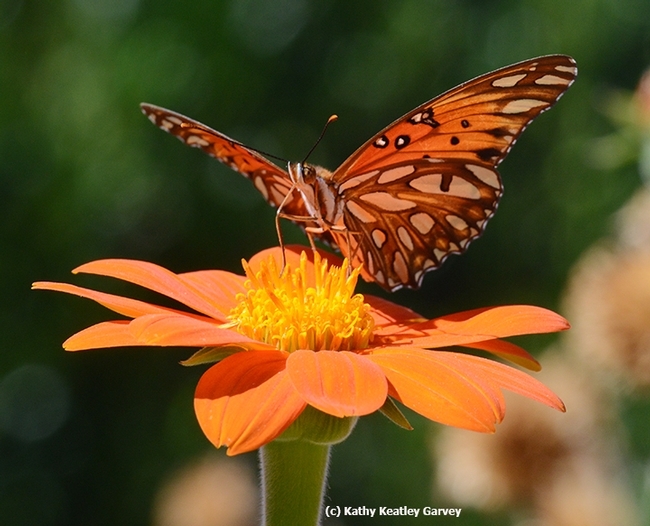
Want Gulf Fritillaries? Plant their host plant, the passionflower vine. This butterfly is nectaring on Mexican sunflower (Tithonia). (Photo by Kathy Keatley Garvey)